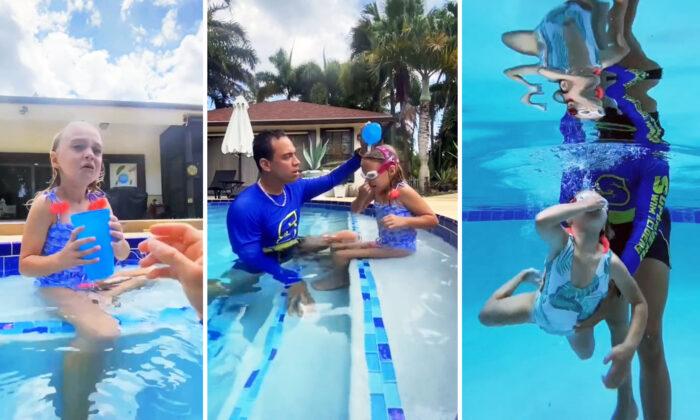A South Florida swim coach is using his expertise to help keep kids safe. By working with children as young as 3 months of age, he is showing even the most fearful kids, and their parents, that they have what it takes to be a swimmer.
Putting his two passions together, teaching kids and swimming, Jacob Siegel, 27, co-founded Superhero Swim Academy in 2018 to teach water safety skills in a fun, dynamic way, as drowning is the leading cause of injury-related death among children aged 1 to 4 years in Florida, and the drowning death rate among kids of the same age is the highest in the country.
Siegel claims that his teaching method, “verbal conditioning”—a method that teaches young kids water acclimation—is guaranteed to work every time.
To employ verbal conditioning, Siegel takes his “cadets” through a series of challenges designed to increase their comfort level in, and under, the water. His techniques meet the kids where they are, but also push them out of their comfort zones from the very first lesson.
His training begins by building a bond of trust through laughter and play, before seeing whether the child he is training is able to hold their breath.
“You pour the water over their face, it runs over their nose and mouth,” he explained. “This is how I can see if the child is holding their breath or not. You can hear it, too ... they'll inhale through their nose, or they might suck in through their mouth.
“But if they’re pinching their face, then I can see, okay, this child’s holding their breath,” he continued. At this point, the child is ready to go underwater.
When his cadets gain confidence through drilling and positive reinforcement, Siegel teaches them more advanced skills such as how to flip and float if they fall into the water.
“I'll drop them in upside down, drop them in on their side,” Siegel explained, “and then I teach them how to swim back to the wall every single time. I’m making a game; you have to make it fun and exciting for the kids. They’re enjoying learning how to save their own lives.”
Siegel said that he started using immersive techniques after a call from a parent who wanted their 8-month-old to take swimming lessons. “I’ve never taught a baby that young before ... I was a little bit nervous,” said Siegel, “so I started YouTubing other swim instructors: What do they do? How do they do it?”
Coming across footage of a verbal conditioning demonstration in a bathtub, Siegel was convinced by the results. “It gets babies underwater as young as 3 months old,” he said.
Siegel—who has worked with various different students including those with special needs and autism—also teaches adults with long-held anxieties about the water. Once he gets them comfortable, he said, he can eradicate an adult’s most irrational fears and teach them to swim in just 30 minutes.
Once a high school varsity and competitive swimmer, Siegel remembers his own parents putting him through swim lessons as a preschooler. To this day, he believes it all begins with parents and the bathtub at home.
https://www.instagram.com/p/CMVrhwtgDCR/
“[It’s] a great opportunity to acclimate your child, especially if they’re very young, because in the bathtub, you can easily do verbal conditioning with the cup of water over their face,” he explained. “If you introduce water to an infant, 1 month, 2 months, 3 months old, it’s part of their growing up ... they’re such little sponges at that young age. They’re learning everything.”
Older children, he advises, should visit a pool at least once or twice a week with a parent who gets in the water with them. However, he cautions against the use of floaties, as they can teach kids bad habits, such as swimming with their heads up.
For safety, Siegel says that all families should try and install fences around their home swimming pools. But in the event of an accident, “reaction time is everything,” with getting the child out of the water, performing CPR, and calling 911 being at the top of the list.
Speaking to The Epoch Times, Siegel says that children who learn to love swimming quickly are easy to teach. “But children who are having a hard time, are really struggling, and are very afraid, they’re definitely more rewarding to work with because you’re helping them overcome a fear,” he said.
Ultimately, Siegel’s top advice is for parents to get in the water with their kids, even if they are cautious themselves.
“Parents, you don’t need to know how to swim to stand in the shallow end of the pool and play with your kids,” he said. “If every parent did that, we wouldn’t have any problems.”
https://www.instagram.com/p/CK_hGLWgPvb/






Friends Read Free